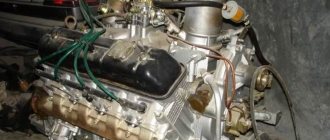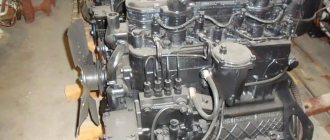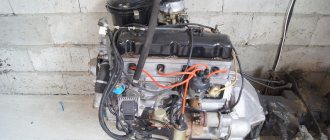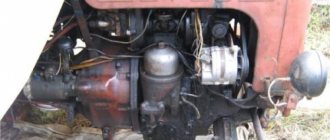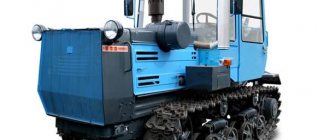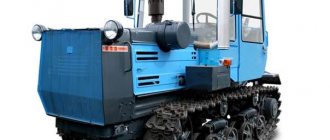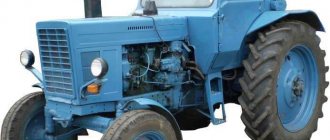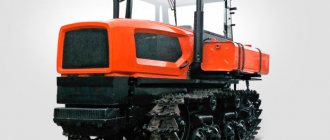The D 245.9 power unit is one of the engines in the D-240 family of diesel engines and their modifications, mass production of which has been carried out at the Minsk Motor Plant (MMZ) for more than 40 years (1974 - present). The motor is intended for installation on general purpose buses and trucks, the total weight of which does not exceed 8 tons.
Initially, the D 245.9 engine was equivalent to the EURO-0 class in terms of environmental characteristics, but the focused work of the development team aimed at improving these indicators made it possible to raise them to the level of the requirements of the EURO-1 class (1998), and then EURO-2 "(2005) and "EURO-3" (2008).
Specifications
Download .xls file
xls
Download picture
Send by email
| MOTOR PARAMETERS MMZ D 245.9 E2 | VALUES |
| Cylinder displacement, l | 4.75 |
| Rated power (at 2400 rpm), hp | 136 |
| Max torque (at 1300 rpm), Nm | 460 |
| Number of cylinders/layout | 4/row-vertical |
| Cylinder diameter, mm | 110 |
| Piston stroke, mm | 125 |
| Compression ratio | 15.1 |
| Number of valves | 8 |
| Number of valves per cylinder | 2 |
| Cylinder Sequence | 1 -3- 4 — 2 |
| Diesel fuel supply system | direct fuel injection |
| Min specific fuel consumption, g/kW*hour | 215+5% |
| Lubrication system | Combined (pressure + spray) |
| Engine oil volume, l | 10.8 |
| Engine oil | 5W-40 (winter), 15W-40 (summer) |
| Cooling system | Liquid, closed type, with forced ventilation |
| Coolant volume, l | 17 |
| Coolant | TS-40 or TS-65 |
| Overall dimensions, mm | 965.5x676x968 |
| Dry motor weight, kg | 500 |
| Motor resource, motor hour | 8000 |
The engine was installed on trucks and buses: ZIL-130, ZIL-4329, ZIL-5301 “Bychok”, PAZ-4230 “Aurora”, MAZ-4370 “Zubrenok”, LAZ-695D “Dana”.
Brief information about the power plant
In the sixty-third year of the last century, a plant for the production of motors was founded in Minsk. Initially, the enterprise was based on the production facilities of the Tractor Equipment Plant (MTZ). It was assumed that the motors would be used exclusively for agricultural needs. Over time, guidelines changed, and there was an urgent need for engines for automotive vehicles.
Power plant D 245:
The eighty-fourth year was marked by the release of the first diesel engine under the abbreviation D-245. Variations of the engine are installed on tractor equipment: engine D 245 2S2, D-245S2, D-245.5S2, and others. In the ninety-second year, a motor with the designation D-245.1 was developed and launched. The unit was modified and put on transport: GAZ-3309, GAZ-3308, GAZ-33081.
GAZ 3309 with power plant D 245:
The base engine is made in the form of an in-line unit, equipped with four vertical cylinders. When comparing the D 240 and D 245 engines, the differences concerned the design of the shaft, which was fixed on five supports, instead of three, as was done with its predecessor. Fuel injection had a different character, due to the installation of a fuel pump with different settings. The diesel volume remained unchanged, 4.75 liters, but the unit parameters have improved. Thus, fuel efficiency did not interfere with the production of 163 horsepower and an impulse of 595 Nm. Overall dimensions of the unit: length 1000 mm, width 702 mm, height 1080 mm, motor weight excluding oil and coolant 560 kg.
The engine was popular: the device is simple and reliable, technically advanced, the engine is still in production to this day. Today the company produces the motor in seven versions. The latest model will be released in 2022. The modification bears the abbreviation D-245.35E5. The unit meets customer requirements and complies with Euro-5 environmental standards.
Description
The D-245.9 power unit is part of the line of four-stroke diesel engines D-245.7 ... D-245.12S, which are modified versions of the well-known D-245 engine. All of them are equipped with gas turbine supercharging and differ from the base model:
- five-bearing camshaft;
- three-groove pistons;
- high pressure fuel pump (HPF), providing higher injection intensity.
In addition, the D-245.9 power unit is equipped with a charge air cooler (intercooler), which increases the density and mass of the air charge supplied to the cylinders.
The basis of the D-245.9 engine is a cast-iron cylinder block housing, in the vertical bores of which removable liners (4 pieces) are installed. The latter are made from a special grade of cast iron. Fuel and engine oil filters, as well as a cooling system pump, are installed externally on the block housing.
The timing camshaft is driven by a timing gear connected to the crankshaft. The camshaft is installed on 5 bearings, the functions of which are performed by special bushings pressed into the bores of the cylinder block. The front hub is made of aluminum, and the rest are made of anti-friction cast iron.
Cylinder block
This is the main body part of a diesel engine - a rigid cast iron casting. The vertical bores of the BC contain four removable sleeves made of a special grade of cast iron. Coolant circulates between the walls of the cylinder block and the liners.
The design of the cylinder block provides for the presence of bosses with covers for five camshaft bearings; an oil channel from which lubricant flows to these bearings and the crankshaft bearings; nozzles in parts of the 2nd and 4th supports - for cooling the pistons with oil jets.
The outer surfaces of the BC have mating planes - for attaching the oil filter, water pump, fuel filters, distribution panel.
Maintenance
The design of the D 245.9 motor ensures its reliable operation during operation. However, in order for the power unit to function smoothly for a long time, it is necessary to remember the need for regular maintenance. Failure to comply with maintenance schedules and poor quality of maintenance significantly reduces the operating life of the engine and leads to increased financial costs during operation.
| Types of Maintenance | Frequency (km) |
| Running in a new engine | 1000 |
| Shift maintenance | 300 — 350 |
| TO-1 | 5000 |
| TO-2 | 20000 |
| Seasonal maintenance | It is carried out during the transition to the autumn-winter or spring-summer periods of operation. Combines with TO-1 or TO-2. |
In general, during any type of maintenance, check:
- engine oil level in the engine crankcase;
- coolant level;
- belt tension;
- contamination of the air cleaner filter elements.
In addition, during every second maintenance-2 it is necessary to replace:
- engine oil;
- filter elements in lubrication and fuel supply systems.
During seasonal maintenance, it is imperative to fill the engine with diesel fuel and motor oil appropriate for the operating season.
Defects and malfunctions identified during maintenance must be corrected immediately.
During operation, special attention is paid to monitoring the operation of the lubrication system of the high-pressure fuel pump (HPFP). If it is left without lubrication, it will fail. Regular replacement of fuel filter filter elements will help to avoid failure of high-precision injection pump parts. In addition, the injection pump must be checked on a special adjustment stand. The testing procedure and requirements for the materials used are specified in the relevant regulatory documents.
Piston
Probably, with this approach, Minsk will be able to overcome Euro-6 for D-245. True, in this case, the “ecological” linkage will be much more expensive than the engine itself.
The main question is: when?
Until the Russian government introduces Euro-5 standards, no one will either produce such engines or buy cars with them. And when the corresponding decree appears, the factories will be harnessed to a new burden... and the cars will become more expensive again: engines of the Euro-5 level a priori cannot be cheaper than the versions for Euro-4 and Euro-3. The final price will depend on the manufacturers of neutralization components, and they are all foreign.
Photo: MMZ
A class higher: how Minsk turbodiesels are modernized
Malfunctions
| Symptoms of a problem | Causes of malfunction |
| 1. The engine does not start. | presence of air in the fuel supply system; |
| fuel pump failure; | |
| The glow plugs have failed. | |
| 2. The engine “loses” power. | malfunction of one or more injectors; |
| the filter elements of the fine fuel filter are clogged; | |
| the fuel pump is faulty; | |
| turbocharger failure. | |
| 3. Engine speed “floats”. | the fuel supply system is contaminated; |
| the gas distribution mechanism is worn out; | |
| The injector spring broke. | |
| 4. Smoke comes from the muffler: | |
| of blue color; | presence of oil in the combustion chamber; excess engine oil in the engine crankcase. |
| white. | water got into the fuel; the gaps between the valves and timing rocker arms are broken; motor hypothermia. |
| 5. Engine oil pressure has decreased when the engine is warm. | insufficient engine oil level in the crankcase; |
| oil filter drain valve jamming; | |
| crankshaft journals and/or support bearings are worn; | |
| The pump in the lubrication system is faulty. |
crank mechanism
The steel crankshaft has 5 main journals and 4 connecting rod journals. The crankshaft connecting rod journals have cavities for additional centrifugal oil purification. The cavities of the necks are covered with threaded plugs.
The axial force of the crankshaft is perceived by 4 bimetallic (or aluminum alloy) half rings, which are installed in the bores of the BC and the cover of the 5th main bearing. To compensate for the load of inertia forces on the main bearings, on the 1st, 4th, 5th and 8th Counterweights are made on the crankshaft cheeks. The crankshaft is sealed with cuffs at the front and rear. At its front end there are gears that drive the gas distribution, oil pump, and a pulley that drives the water pump and generator. A flywheel is mounted on the rear flange of the shaft.
The pistons are made of aluminum alloy. At the bottom of the pistons there are combustion chambers, offset relative to their axes. There are 3 grooves in the upper part of the piston - compression rings are installed in 2 of them, and an oil scraper ring is installed in the 3rd. The piston bosses have holes for the piston pins. The piston pins are hollow and made of chromium-nickel steel.
The connecting rod is steel, I-section, with a bushing pressed into the upper head. The upper end of the connecting rod and the bushing have holes for lubricating the piston pin. The crankshaft main and connecting rod bearing shells are made of bimetallic strip. The flywheel is made of cast iron and is bolted to the crankshaft flange.
Tuning
The design features of the D 245.9 power unit make it possible to relatively easily increase its power without resorting to major alterations. For example:
- By replacing the existing exhaust system with a more modern one, you can get an increase in power by about 20...25 hp. With.;
- A higher-pressure turbocharger installed in place of the standard one will help increase engine power to 150 hp. With.
When deciding to carry out work that will lead to an increase in engine power, it is necessary to consult with specialists who have experience in carrying out such work. Qualified auto mechanics will be able to increase the power of the D-245.9 engine up to 200 hp. pp., replacing the crankshaft, injectors, fuel pump, turbine and carrying out a comprehensive setup.
In addition, by contacting a specialized auto repair shop, you can use chip tuning to improve the dynamic characteristics of the engine, while simultaneously eliminating factory firmware errors.
IMG_6288
Depending on the power of the engines and customer requirements, different exhaust gas purification technologies are used to comply with Euro-5 environmental standards. The D‑245.7E5 (130 hp) and D‑245.9E5 (136 hp) turbodiesels use exhaust gas recirculation (EGR) with a liquid heat exchanger in combination with a particulate filter. And the D-245.35E5 engine (177 hp, 650 Nm) is equipped with a selective catalytic reduction (SCR) system with the injection of an aqueous solution of AdBlue urea into the exhaust system equipped with a converter. All neutralization components are imported.
This is interesting: D-260 - engine technical characteristics
